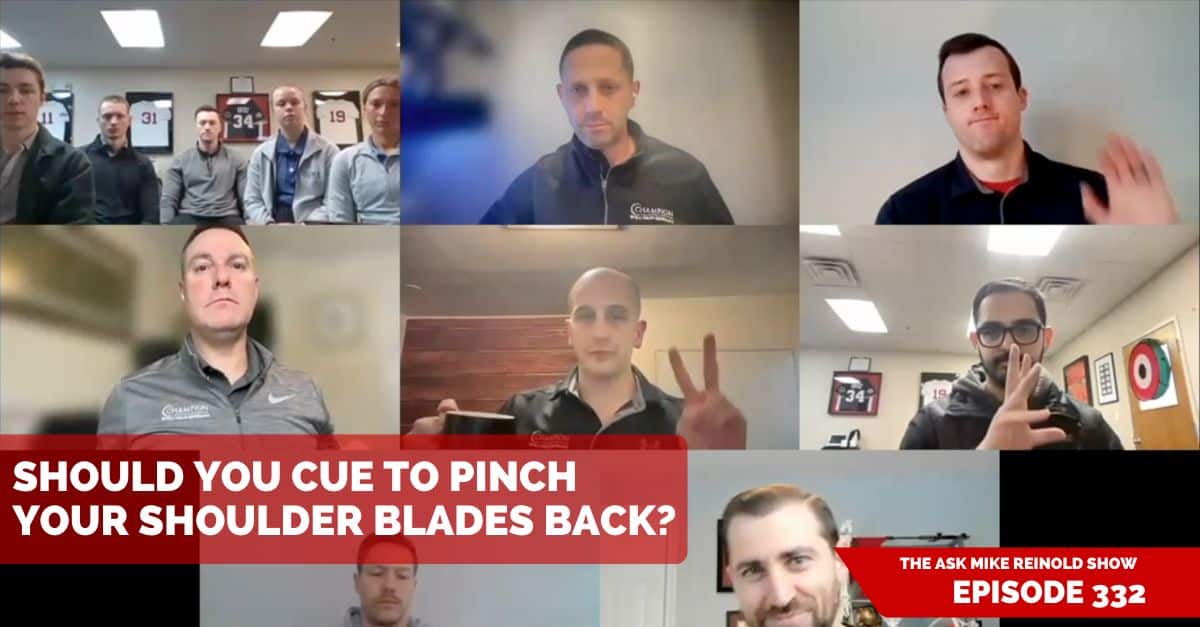Scapular dyskinesis may be one of the most over diagnosed thing we see in our clinic at Champion.
Sometimes scapular winging is a problem, or at least the result of a problem. But other times it may be normal for the person.
Here’s how we tell the difference.
To view more episodes, subscribe, and ask your questions, go to mikereinold.com/askmikereinold.
#AskMikeReinold Episode 259: Is Scapula Winging Always a Bad Thing?
Listen and Subscribe to Podcast
You can use the player below to listen to the podcast or subscribe. If you are enjoying the podcast, PLEASE click here to leave us a review in iTunes, it will really mean a lot to us. THANKS!
Show Notes
Transcript
Student:
So Isabelle from Illinois. Is there a difference between having flexible shoulder blades, and having a scapular dyskinesis? Can you have shoulder blades that stick out during certain movements and not necessarily have winged shoulder blades?
Mike Reinold:
I like that question. The first thing I thought of was literally a scapular that could like bend. Like a cartilage one. Flexible shoulder blades.
Dan Pope:
Like a shark fin. Like that.
Mike Reinold:
Yeah, that sounds terrible. Isabelle, I know that’s not what you’re asking, but my brain did go there for a second. So I think that’s a great question, right? Because we always think that there’s like this established norm, like there’s one type of person out there, right? So we even see this in sports. Mechanical things where somebody is like, oh, I don’t like the way their scaps are moving. And I’m like, for you, that would be excessive motion of their scapula. But for them, that’s not an excessive motion. Right? They have a ton of motion in their scapulas. So we see this all the time with people where either their resting posture, their scaps are sitting a little off. Or maybe dynamic posture, there’s a lot of movement and winging going on.
Mike Reinold:
So I guess the real question here isn’t how do we label that? I guess the real question is when do we… I don’t even think we’re going to say, when does that become pathological? Because I don’t think that’s the right answer. Is when does that become suboptimal? Is there a such thing as just having excessive mobility, and not being like dyskinesia? Meaning like we need to fix it. Is there ever a time you don’t fix it? So who wants to start? That’s a good one.
Dave Tilley:
Wow.
Mike Reinold:
Curve ball, Josh. No, you’re not Josh. Isabelle. Isabelle threw us a curve ball. Now what’s up Dave?
Dave Tilley:
Lenny can lead the dance step.
Lenny Macrina:
Yeah. I mean… I don’t know. I think we’re walking a fine line. Just the way things were labeled in that question leads me to believe… I need to either redefine how I’m looking at the scapula, or we as a profession need to redefine how we’re looking at the scap. I think we get so caught up with the minute details of… Especially the scapula. It’s weird how like scapular dyskinesia can have all these different definitions, and how we can somehow apply it to that person that’s in front of us. I think we just need to be very careful with some of that stuff. Sometimes, because we can really freak somebody out by saying that they have winging causing all this. And sometimes winging does. Like you can. You’ve got somebody who normally had a normally sitting shoulder blade and all of a sudden they show up like this.
Lenny Macrina:
I mean, to me, that’s something going on. I had a few baseball players over the years that just randomly showed up with a winged scapula and that’s not normal for them. So that would, to me would be pathological and we need to address that. But somebody who maybe has it, but when they get up into a throwing position it corrects? I’m not as concerned with that. And so people get caught up because they’ve seen previous healthcare providers, doctors, PTs, athletic trainers, anybody, that have kind of gotten in their head with that. And it’s up to me to figure out, does this truly correlate with their symptoms, and their dysfunction? Or can we just kind of educate, get through it and figure out what are the true causes of their issue? You know?
Mike Reinold:
Yeah.
Lenny Macrina:
So it’s tough to say, I’m being vague. But I get… I don’t know, you get caught up with these different terms and it can be detrimental for the person. So I’d be careful.
Mike Reinold:
What’s up, Dan? What do you think?
Dan Pope:
I agree. And I think the big thing is that we’re not really sure if dyskinesia is bad, is it normal, is okay to have this. And the research is very mixed, and more recent research shows maybe it’s not as important as we once thought, right?
Mike Reinold:
Can I jump in right there too? Because this is the narrative on the internet again. And I want to still jump in right here. You’re never going to be able to conduct a research study. That is the most broad question is, does dyskinesia cause pain? That is a really unrealistic research study that makes no sense. I’m just going to jump in as still as just say here, suboptimal is not okay for me. Right? So I wanted to leave right there. And everybody wants argue that, does this even mean anything? Yeah, it doesn’t lead to injury, but that doesn’t mean you’re optimal. Right? And there’s, there’s a lot of negatives with that. So sorry. So, based on that, Dan, like keep going, but I hate how everybody’s trying to say that… Don’t worry about anything. I think we’re definitely putting people in disadvantageous positions. So, sorry. I got upset.
Dan Pope:
Yeah. I kind of see it as… If you’re a physician, you get crapped on all the time because you’re just addressing these diseases with like a pill or something. Right. And then people are crapping on it because they want to optimize health. I think that oftentimes physical therapy, that’s the same thing. We can probably tweak that movement to make them better at a given sport. We’re definitely sports providers. I guess what I was going to say is that it just gives you a little extra information about the shoulder blade. And Lenny talked about this before. If you’re moving a lot from the shoulder blade on one side, why is that happening?
Dan Pope:
I mean, I’d see this all the time in people that have shoulder pain or they have shoulder stiffness with either the capsule, or maybe the Teres Major. And if I have an overhead athlete that needs to have as much overhead mobility as possible to perform a snatch, or just more than they have currently, and I see a lot of upward rotation on one side, one of the first things I start thinking is like, okay. This person has limited overhead, but they’re moving at Tom from the shoulder blade, what’s going on within that shoulder joint? Is the Teres Major stiff? Should we start working on that? And it also really depends on the person, right? So if I have… Let’s say a sixty year old woman that comes in with shoulder pain and she’s got a little extra upper rotation and she doesn’t necessarily need a ton of mobility, maybe I’ll go down that same pathway of, okay, well maybe we need more motion within the joint, but maybe we don’t. So I guess it really comes down to the person, gives us more information, and we can start our clinical reasoning from there.
Mike Reinold:
I like that. And I think you both… Lenny and Dan, you both kind of said it here. It’s almost like what’s happening at the scapula may be a clue that there’s something else that we need to look at. Which is great. Is it a nerve? Is it a weakness? Is it the shoulder joint? Is it the thoracic spine? Like what it is? It’s almost like that’s the result.
Lenny Macrina:
So I’ll just say, just remember the scapula is just kind of sitting there. It’s just floating. It’s influenced by everything around it. That thoracic spine, the muscles that attach there, there’s so many different influences to it. So to just blame the nerves, like if we’re talking a long thoracic nerve thing? So the scapula is just kind of this like floating bone that is looking for direction. So.
Mike Reinold:
Yeah. What do you think, Dave?
Dave Tilley:
Yeah. I just think like the scapular dyskinesia is, and then also patellar tracking are two of the most kind of frequent victims of this. As PTs, we oftentimes want to have an answer. We want to find something that’s wrong. We want to make it work and find something that’s going to help the person. It’s with well intentions. But like, so many times I’ve made this mistake, and I see other younger clinicians make that mistake. They immediately jump to the thing right in front of them and it’s like, oh, it’s a winging scap. That’s why your shoulder hurts. Case closed. Let’s do some exercises. Right? It’s a much more complicated system than that.
Mike Reinold:
Yeah.
Dave Tilley:
I think oftentimes we look for the biomechanical thing right in front of us, but there’s so many other things that probably are way more important to think about like Lenny said. Like maybe they’ve always had winged scaps. Maybe they’ve always had an issue with the way that their needs are. It’s anatomical, but they had a full, a hundred percent spike in their workload recently. Or they’re doing something new or they’re trying to new skills or they just haven’t been doing this training conditioning program and their cuffs getting a little bit weak and they’re just sore from that. So I think it’s hard sometimes. Because it means you really got to check your own biases about what you think the answer might be, what you want the answer to be because you took this new course over the last few weeks and you want to use the material. But I think sometimes you got to be really careful about being like, all right, there’s a lot of things that could possibly be, let’s not jump to conclusions.
Dave Tilley:
And everybody in this call works with some people who are really hyper mobile, have some crazy anatomical, unique things about throwing, whatever else, that they probably wouldn’t be a great athlete if they didn’t have them. So like I see a lot of people like gymnasts with crazy wing scaps and like crazy hyper mobility. And they’re like, no, I feel great, I feel fine. And I’m like, oh.
Mike Reinold:
You know, look. I’m reflecting now. And I think that really was helpful, because I can’t remember the last time I actually thought that this was somebody’s problem. Right? Now don’t get me wrong, some scapular movement issues, so we’ll call that dyskinesis or whatever you want to call it. I oftentimes think that’s part of their suboptimal checklists that I create for the person, but I almost never think that it’s their number one problem. And it’s their thing that’s causing the pathology. It’s just part of the equation sometimes. I like that. So Lisa, you got a little bit?
Lisa Russell:
Yeah. I mean, I feel like I… In learning from you all over the past year plus, all of these things for shoulders is something that I’ve like completely changed, how I look at shoulders. Like I feel like I, like the person asking this question, I feel like I used to look at just positioning and whatever and just being, oh my gosh, here you go. I found your problem. And I feel like knowing, learning from you all, more sports specific aspects and just like different ways to look at how things move, and everything we’ve talked about has really changed my outlook on shoulders.
Lisa Russell:
And something really cool that I kind of just had an aha this week was a rower that I had the opportunity to work with. She had like no shoulder pain, but just like watching how she was rowing was just like, my goodness. You’re just like not using that shoulder, scap positioning connection well. Like you’re not optimizing that piece of your stroke at all. And during the winter, she did a ton of shoulder strength work. And now I just got to go on the water and watch her row yesterday, and it’s an incredibly different picture. She had no pain to begin with, but now her stroke is so much more connected and so much more powerful because we found that non optimal function of her shoulder, and not necessarily pain driven. And I feel like it’s… She hasn’t necessarily changed how her shoulder blade sits. Right? But like the…
Mike Reinold:
Right. She didn’t change her rib cage. Right? Like to rib cage is still the same rib cage.
Lisa Russell:
Right. Yeah. Same bones.
Mike Reinold:
Right.
Lisa Russell:
So, I feel like shoulders are way more complicated in that way. There’s not like one way to just like stare at somebody’s back and go. And yeah. I don’t know. It’s just a really cool different outlook on how it all works, to not think just a wing scap means bad things.
Mike Reinold:
Yeah. And I think I would end it with this too. And kind of summarizing, Dave mentioned this, everybody kind of mentioned this. Lisa mentioned a little bit too. Just because somebody has the ability to wing their shoulders… So I think that’s what a little bit with Isabelle is saying is like, they have the ability to wing their shoulders. I’ve had patients sit there and they can go like this and then all of a sudden it’s this gigantic, crazy… Yeah. Tilly could probably do that. We may have to prove that too. We’re going to get a video of Dave’s scapula and Mike’s subluxing perinatal tendons.
Dave Tilley:
I’m right here, do it right now.
Mike Reinold:
Yeah. But like, just because you can wing, as long as it’s not winging during your functional activity. Right. Because again, think about it. I don’t want to be the person that says your winging isn’t necessarily bad for you. If I’m a baseball pitcher and I get my arm up to this position and it does this, this changes everything about my shoulder position. So I’m not going to say that’s bad, but I’m sure as hell not going to say that I don’t care about that. Right? That’s very short-sighted. So for me, I think it’s okay if you can move them and wing them as long as functionally, when you’re doing activities, they don’t wing. I think that’s the key to it. That’s the control of it.
Mike Reinold:
If somebody is just a mess and they just can’t do that, there’s you start thinking neurological, deeper types of pathologies that may be happening. But I think the key for me is that some people have excessive mobility in their scapula. It’s all about just can they stabilize it during their functional activity. So think of it that way. I don’t think we’ve labeled anybody as a diagnosis of scapular dyskinesis, and as long as we’ve had champion, right. That’s never been anybody’s diagnosis. So kind of keep that in mind. So good question Isabelle, hopefully that helped. If you have a question like that, please head to Mike Reinold dot com, click on that podcast link, fill out the form to ask us questions, and be sure to subscribe, rate and review us on Apple Podcasts, Spotify. And we’ll see you in the next episode. Thanks again.





